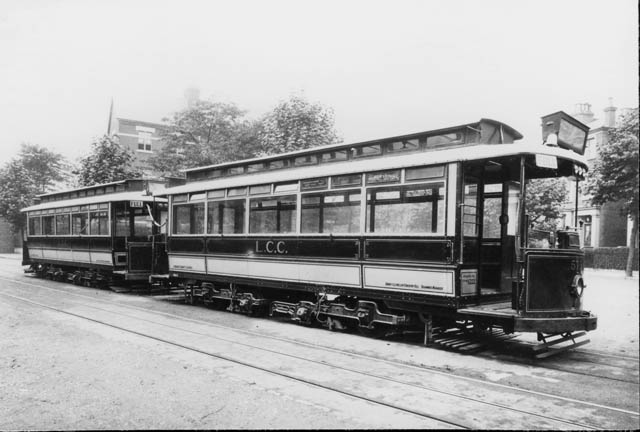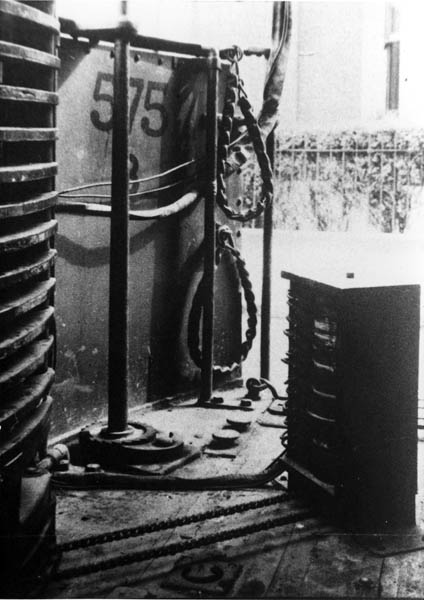LCC Coupled Cars
On the 13th of November 1905 permission was sought by the LCC to use coupled cars in the Kingsway Subway and between the subways northern exit and the Angel, Islington. The police did not object to coupled cars running in the subway, but did object to coupled cars street running. This was on the grounds that the street tracks to Islington and beyond went through narrow streets and had heavy horse drawn traffic. No further action was taken on this matter by the LCC for anther three years.
In 1909 the issue of coupled cars was raised agan. The LCC proposing to the Metropolitan Police Commissioner that trailer cars would not be run between 10:00am and 4:00pm and would be used only to relieve pressure during peak hours of operation. The Commissioner proposed that if the LCC made an application to run trailers experimentally he would consider the application. The chief officer of Tramways A. L. C. Fell reported on a the design of a trailer car. This was really a two car multiple unit the motors and brakes of the leading car being controlled as normal and those of the rear car controlled by electromagnetic switchgear similar to that used on the London Underground at the time.
 |
The two 'coupled cars nos.575 (leading) and 572 posed outside Holloway Depot in Pemberton Gardens. |
A formal request was made to the Metropolitan Police to allow running on the Euston Road - Hampsted Heath route. This was granted providing that the trailer(s) did not operate between 10:00am and 5:00pm. An order was placed with The British Thomsom-Houston Company Ltd. in March 1910 for "control apparatus for subway cars (class 'G')" following a document that BT-H had prepared earlier for the LCC. By December 1910 the two G-Class cars numbers 575 and 572 had been equipped for use as a two car coupled set with brakes and all four motors being controlled from either end of the set. This gave a total of 72 seats per set. The total length of each car was 33ft 6in, giving a total length of the two car set as 68 feet including the gap between the units. Both cars took current from the conduit separately so each car used a plough. Operation would have been difficult as the driver would have to switch off the current twice at section gaps in the conduit and there may have been problems if the polarity of the live 'T' section rails in the conduit was reversed.
 |
A somwhat rare photograph of the Sprague - British Thomsom-Houston
Company's Multiple Unit equipment fitted to the B-end of 'G' clas car 575. It shows the box (on the right) with the electromagnetic equipment connected by a chain drive to the main controller on the left. There is little room for the passage of passengers let alone for the driver to stand to perform his duties. With the possibility of feet getting caught up in the chain-drive of the equipment, it is assumed that this layout was experimental. |
The two coupled cars were inspected by the board of trade on January 13th 1911 and the inspecting officer was very satisfied with the equipment and the performance of the cars.
On the 17th January 1911 the coupled cars started service running between Euston Road and Hampsted Heath, unfortunately on the 1st February the police refused to renew the license of car 572. They stated that they were not satisfied with the time of day during which the cars were allowed to run. They also alleged that some mishaps had occurred and asked the Board of Trade to reconsider the running of coupled cars. On 20th January 1911 the unit derailed in Euston Road, on 21th January the coupling broke at Chalk Farm, On February 1st a power surge on a crossing caused the trailing car to derail. However to most serious incident was on the 27 January the cars had run into the back of a bus that had pulled up sharply to avoid some children in the road (it was 572 that hit the bus). The police attributed this accident to the drivers inability to stop the coupled set owing to the extra weight and momentum.
Eventually the police agreed to a further months running and the cars ran daily between 13 April and 13 May, excluding Sundays and Easter Monday.
The LCC decided that the times of day that were allowed for coupled cars to run was not worth the extra expense and the scheme was discontinued. Eventually the two coupled cars were uncoupled and the LCC decided to persue the idea of a conventional tram towing a single unpowered trailer.
In 1931 the Kingsway Subway was rebuilt to accept double-deck cars thus doubling its capacity.
However, during the Great War the LCC built another coupled car unit at Charlton CRD. Two open wagon bodies were each mounted on surplus Brill 21E trucks and coupled together. The late Richard Elliott believed this unit may have been both conduit and overhead equipped to use the Woolwich - Eltham route and to access CRD. The Eltham route at that time passed numerous market gardens and this unit was possibly used to bring produce down to Woolwich and its market in Beresford Square. After the war there is only one known occasion of its use before being split and rebuilt into rail-grinders 013 and 014. During a railway strike in 1924, the unit was used
to convey staff to and from the Charlton CRD. (Hope it did not rain!)
You can find out more about the LCC trailers both powered and unpowered in both volumes of "London County Council Tramways" by
ER Oakley and CE Holland.
The LCC was not the only London operator to use coupled cars. The MET too experimented in 1926 and 1927 and this is documented in Volume 2 of "The Metropolitan Electric Tramways" by CS Smeeton.
![]()
© Copyright John R. Prentice Software 2015-2023. Wills photo copyright TLRS.
